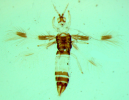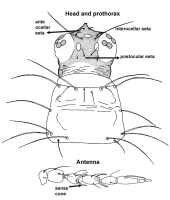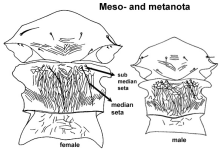 |
Scientific nameScolothrips asura Ramakrishna Ayyar & Margabandhu, 1931
Taxonomic positionThysanoptera: Terebrantia: Thripidae
DiagnosisBody bicoloured; head, pterothorax, and abdominal segments I, II and VI to VIII dark brown and with crimson internal pigment. Antennal segment I, II dark brown. Fore wing with 2 clear areas shaded up to a little before middle; thereafter clear in about 1/4 of wing length, distal 1/4 of wing dark but with a clear apical area about half the length of clavus.
Head with 2 pairs of anteocellar seta. Eyes with 4 pigmented facets. Interocellar setae very long, about along as or longer than dorsal length of head. Maxillary palp 3-segmented. Antennae 8-segmented; segment I without dorsal apical setae; II with dorsal setae baasd of companiform sensilla; III & IV with forked sense cones; V with only 2 sense cones. Pronotum with 6 pairs of long setae. Pronotum without prebasal setae. Ferna divided, the distance between 2 halves very little. Basantra membranous without setae. Medain pair of mesonotal setae inserted at middle of the sclerite. Mesothoracic sternopleural sutures absent. Metascutum with longitudinal closely spaced lines of sculpture.Spinula present on both pterygosterna. Tarsi 2-segemented. Fore wing posterior cilia undulated. Radius (upper vein) of fore wing with 7 setae, cubitus (lower vein) with 6 setae, clavus with 3+1 setae. Tergum X not split. Abdominal terga and sterna with craspedum. Abdominal tergum II with 2 major lateral setae. Tergum III unsculptured in middle; I and II with closely spaced lines of sculpture at middle. ImagesDistributionIndia: Delhi, Maharashtra, Tamil Nadu; Bangladesh; China: Hainan.
Hosts / PreyIt is a predator of spider mites and scale insects.
Reference
|




